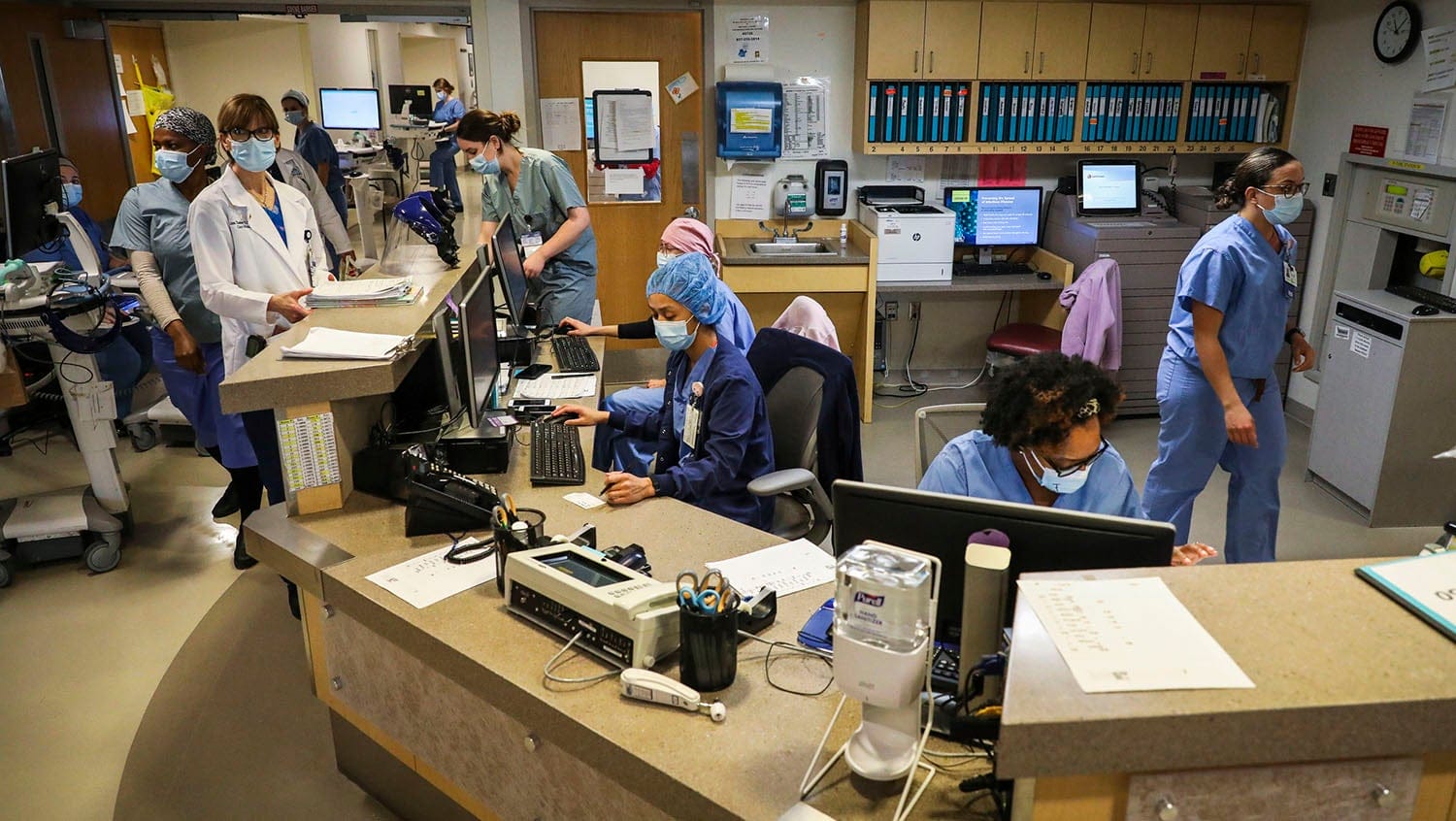COVID-19, One Year In: An Infectious Disease Doctor's Perspective
March 22, 2021

Boston Globe, Getty Images
Global health expert and infectious disease doctor Davidson Hamer, MD, looks back at what we've learned in a year and how it can inform healthcare strategies moving forward.
Boston Medical Center admitted its first COVID-19 patient on March 13, 2020. Now, one year later, the country is still amid an ongoing pandemic. At the same time, with three FDA-approved vaccines being distributed — Pfizer-BioNTech, Moderna, and Johnson & Johnson — those in the healthcare industry are starting to look to the future at the lasting impacts of the COVID-19 pandemic.
Davidson Hamer, MD, an infectious disease specialist at Boston Medical Center and professor of Global Health and Medicine at the Boston University School of Public Health and School of Medicine, spoke with HealthCity about where we are one year into the pandemic and what comes next.
HealthCity: To understand where we are going, we have to look at where we have been. What stands out to you as what we’ve learned over one year in the COVID-19 pandemic, as an infectious disease physician and global health expert?
Davidson Hamer, MD: We’ve learned so many things, I don’t even know where to start. We’ve learned a lot about the transmission of COVID-19 and how to better curtail it — obviously the vaccines are a big part of that equation.
A year ago in January, we didn’t even know there was transmission to human-to-human. Then we learned about asymptomatic and presymptomatic transmission — and all of those are important because what we eventually learned is that most transmission is not from contaminated surfaces or close contact with secretions from somebody who’s infected, but appears to be through aerosol and large respiratory droplets. And that’s where the mask culture as a strategy to help control the disease came up. Research has since shown that, in places that have good high level of mask use, cases dropped down; whereas places where there’s less mask use or where there’s indoor dining with masks off had a rise in cases.
And I think we’ve learned how to treat patients with COVID-19 better. Some of the medications can slow the process of disease and potentially prevent hospitalizations, like monoclonal antibodies. And then our management of patients in the hospital has improved so that we’re now using steroids routinely to reduce infection-associated inflammation, biologics to try and prevent progression, antivirals to try and catch it even earlier, before it progresses to more severe disease, and other strategies that will help avoid the need for intensive care admission and actual death.
Those are just a few of the things we’ve learned.
HC: With all of that, from your perspective, where do we stand now in the COVID-19 pandemic?
DH: We’ve had unbelievable progress in terms of treatment, our understanding of treatment, our understanding of the disease, its transmission, and preventive measures for transmission, but we’re not done yet.
There’s still disease transmission — more than 1,000 new COVID-19 cases reported to the State Department of Public Health each day in Massachusetts. In addition, there are other hints of things that are worrisome, including the wastewater data at Deer Island. The other thing that’s happening is, as we’re starting to do more sequencing, there’s growing evidence that the U.K. variant is circulating. And that strain appears to be more readily transmitted for different potential reasons and it may be more lethal.
We have had the great fortune to have COVID-19 vaccine production go at lightspeed to the point where we now have three approved vaccinations in the United States and are getting those out. There have been bumps in the road in terms of distribution, but there’s progress.
We’re not done. We need to really keep up our guard.
HC: Can you explain what you mean by the wastewater data?
DH: If you look at the Massachusetts Water Resource Authority data, there was a lot more virus being excreted by people—therefore, presumably circulating in our community, from October into February. It has come down, but at least as of the most recent measurement, it has not returned to the low levels that we had last summer. We need to watch that to see if it starts to go back up again. It works as an early warning indicator of disease transmission in the community.
HC: From here, have we learned anything from prior pandemics that may inform how we move forward?
DH: The most recent pandemic in the U.S. was the 2009 H1N1 influenza pandemic. For influenza, we have vaccines that work relatively well, but they constantly need to be modified. The COVID-19 vaccine development has been a fantastic move forward, but as new strains continue to emerge, if the virus changes enough that it starts to escape coverage by the existing vaccines, we’ll have to adapt COVID-19 vaccines so that boosters target the more common strains that are circulating at the time. Every pandemic is different, but that’s similar to the approach that we take with influenza each year.
HC: There’s research about lasting health impacts on people who’ve been diagnosed with COVID-19. How do we move forward delivering care for these patients?
DH: We need to understand more about the post-acute complications. First of all, what is the pathophysiology? What are the underlying mechanisms for these? And then, as we can understand that, we can then develop strategies to try to address them. Some interventions may just be basic things, such as physical therapy and mental health interventions, but some could be pharmacologic interventions. Clearly, we need multi-disciplinary approaches to managing the long-term complications — both in researching and understanding them, but also in managing them.
HC: It’s inevitable that at some point, the U.S. will experience another pandemic. What have we learned from our response to COVID-19 that would inform how we might respond to a future pandemic?
DH: One is a rapid scale-up of testing, including active surveillance testing and not just testing people that have symptoms, but people that don’t have symptoms. Then, a strong response with isolation of COVID-positive people and effective, rapid contact tracing to identify their contacts and quarantine them. All of that can help really slow the progress of the disease. And the places that have been really successful, like Singapore and Taiwan, for example, have used those strategies.
We’ve learned a lot about testing using the PCR diagnostic test as a core test and bringing the cost down with different strategies for specimen acquisition and extraction and running the tests. There’s been a lot of work in the development of antigen tests — they’re not quite as effective as we’d like, but they are useful and much less expensive, and could be part of the test solution moving forward.
Two is being ready in terms of recent hospital level with adequate amounts of personal protective equipment. Then, strategies and protocols for trying to limit the spread in hospitals. There were hard lessons learned in the first two weeks of March last year when we kept seeing one infected healthcare worker after another. Once we had universal mask use in the hospital, the rates of new infections in healthcare workers dropped dramatically.
Three, if we’re not using masks at the point of the emergence of a new pandemic threat, it would be important to have them available and have a culture where we’re used to using them. When COVID-19 started to spread in Japan, everybody knew to start wearing masks — not by public mandate, it was just automatic, a part of the culture. I think we need that kind of reflex in the U.S. too. Flu season this year is the mildest in decades and other respiratory viruses are down. I think that people will realize that by changing their behaviors, they can reduce their risk of infections.
This interview has been edited and condensed.


